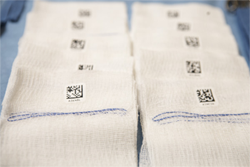Another way to avoid mistakes in surgery


Today the founder of a competitor I mentioned in that story, SurgiCount Medical, called to offer his side of the story.
Brian Stewart developed a way to bar code surgical gauze before packaging, and can offer tracking of those gauzes for about $15 per surgery.
He calls it the Safety-Sponge, and each identifying marker is a "master tag" that can be matched before an operation and afterward. A Chinese partner makes the gauze, uses a thermal printer to tag them, and Cardinal Industries then distributes them here. (Yes, they look like monogrammed handkerchiefs.)
Leaving a sponge inside a patient is a "never event" that actually happens just once in every 5,500-7,500 operations, because some procedures, like a prostate removal, can use over 150 gauzes that become red and thus hard to find.
In California Medicare and Medicaid won't reimburse hospitals for these events, and impose fines starting at $75,000 for each incident. Then there are the legal costs, up to $250,000 each, and you have to fix what went wrong.
The RF Surgical approach is to "detect" sponges before an operation concludes, he explained, while SurgiCount's approach is to count them both before they go in and afterward.
You can argue about whether counting will theoretically work, but "we've done 250,000 procedures, using 6.25 million Safety-Sponges, and there have been no incidents with our system."
So you do the math. For about $15 your hospital can prevent something that, even if it happens just once in every 7,500 operations, will still cost you hundreds of thousands of dollars to deal with. And risk your patients' lives.
I don't know whether RFID or thermal-printed bar codes are the right way to go. But if you do the math, using some technology seems eminently reasonable.